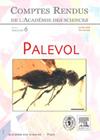The extended osteoderm shield in Paleosuchus sp.: a dwarf crocodylian adaptation to the equatorial forest ecosystem?
IF 1.2
4区 地球科学
Q3 PALEONTOLOGY
引用次数: 0
Abstract
The crocodylian dwarf species (i.e., Osteolaemus sp. and Paleosuchus sp.) that live in the equatorial forests all share the peculiarity to present an osteoderm shield which extends beyond the dorsal area that lies between the skull and the caudal crest symphysis. Here we study both the morphology and the microanatomy of the osteoderms in Paleosuchus palpebrosus (Cuvier, 1807), in order to both assess the distribution of bone ornamentation over the osteoderm shield, and to compare the porosity between the dorsal osteoderms with the non-dorsal osteoderms. Since both the ornamental pit excavation and the bone porosity are relevant proxies to the osteoderm blood vessel content, we mapped the distribution of the vascular network within the osteoderm shield in P. palpebrosus. Our results show that both the bone ornamentation and the bone porosity are significantly more pronounced within the dorsal shield osteoderms. Our results suggest that the dorsal osteoderms may be involved in heat transfer via the superficial blood vessels that are located in the ornamental pits if they are artificially exposed to a basking lamp in captive conditions; it is however unlikely to be the case under the canopy of the equatorial forest since the sun exposure is poor. We therefore hypothesize that the dwarf crocodylian extended osteoderm shield mostly consists of a labile calcium resource that would allow to buffer the diet variations which are related to the various equatorial forest niches (i.e., streams, excavated pools, jungle floors, caves).古蜥的扩展骨盾:一种适应赤道森林生态系统的侏儒鳄?
生活在赤道森林中的侏儒鳄类(即Osteolaemus sp.和Paleosuchus sp.)都有一个共同的特点,即它们的骨皮盾延伸到头骨和尾嵴骨骺之间的背侧区域之外。在这里,我们研究了掌骨蜥(Cuvier,1807 年)骨膜的形态学和显微解剖学,以评估骨膜屏蔽上骨装饰的分布情况,并比较背侧骨膜与非背侧骨膜之间的孔隙率。由于装饰坑的挖掘和骨孔隙率都是骨皮血管含量的相关代用指标,我们绘制了腭蟾蜍骨皮屏蔽内血管网络的分布图。我们的结果表明,骨装饰和骨多孔性在背盾骨皮内都明显更明显。我们的研究结果表明,如果在人工饲养条件下将背盾骨皮暴露在日光浴灯下,背盾骨皮可能会通过位于装饰坑内的表层血管参与热传递;但在赤道森林的树冠下,由于阳光照射不足,这种情况不太可能发生。因此,我们推测侏儒鳄的扩展骨盾主要由易溶的钙资源组成,可以缓冲与不同赤道森林壁龛(即溪流、挖掘的水池、丛林地面、洞穴)有关的饮食变化。
本文章由计算机程序翻译,如有差异,请以英文原文为准。
求助全文
约1分钟内获得全文
求助全文
来源期刊

Comptes Rendus Palevol
地学-古生物学
CiteScore
2.10
自引率
0.00%
发文量
39
审稿时长
17.6 weeks
期刊介绍:
Comptes Rendus Palevol is a fully electronic and peer-reviewed journal, with a continuous publication stream, devoted to palaeontology, prehistory and evolutionary sciences. It publishes original research results, in French or English, in the following domains: systematic and human palaeontology, prehistory, evolutionary biology and macroevolution, and history of sciences. Thematic issues may also be published under the responsibility of a guest editor. All articles published in Comptes Rendus Palevol are compliant with the different nomenclatural codes. A copyright assignment will be signed by the authors before publication.
 求助内容:
求助内容: 应助结果提醒方式:
应助结果提醒方式:


